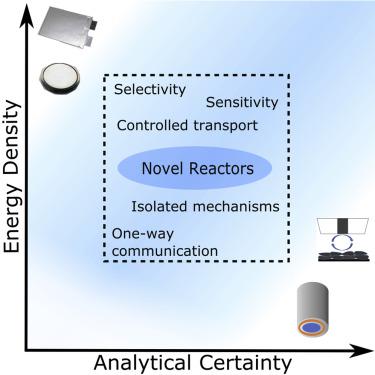Joule ( IF 38.6 ) Pub Date : 2021-01-20 , DOI: 10.1016/j.joule.2020.12.022 Sophia E. Lee , Oliver C. Harris , Tana Siboonruang , Maureen Tang

|
Complex side reactions drive capacity fade in modern Li-ion batteries and are a key factor in achieving extended battery lifetimes. Unfortunately, the interconnected nature of the reaction pathways means that optimizing one aspect of performance can result in a shift between benign and detrimental side reactions, and that simple Coulombic efficiency is unable to capture these differences. Because batteries are ultimately chemical reactors, reaction engineering principles can provide a suitable framework for understanding. The electrocatalytic systems of Li-O2 batteries and electrochemical CO2 reduction demonstrate both the importance of quantifying reaction selectivity and the key role that reactor geometry plays in this process. Recent findings from these fields suggest that battery side reactions should also be studied in reactors that have been optimized for analytics. In this reaction engineering context, we discuss the advantages and disadvantages of existing analytical tools and present pathways for designing new reactors that can directly evaluate Li-ion battery reaction selectivity. Quantification of selectivity and reaction parameters can direct materials design and improve lifetime prediction.
中文翻译:

非水电池寿命的反应工程方法
复杂的副反应会导致现代锂离子电池的容量衰减,并且是延长电池寿命的关键因素。不幸的是,反应路径的相互联系的性质意味着优化性能的一个方面可能导致良性和有害副反应之间的转移,而简单的库仑效率无法捕获这些差异。由于电池最终是化学反应器,因此反应工程原理可以为理解提供合适的框架。Li-O 2电池和电化学CO 2的电催化系统还原反应既证明了量化反应选择性的重要性,也证明了反应器几何形状在该过程中所起的关键作用。这些领域的最新发现表明,也应在针对分析进行了优化的反应堆中研究电池副反应。在这种反应工程的背景下,我们讨论了现有分析工具的优缺点,并介绍了设计可直接评估锂离子电池反应选择性的新型反应器的途径。选择性和反应参数的量化可以指导材料设计并改善寿命预测。











































 京公网安备 11010802027423号
京公网安备 11010802027423号